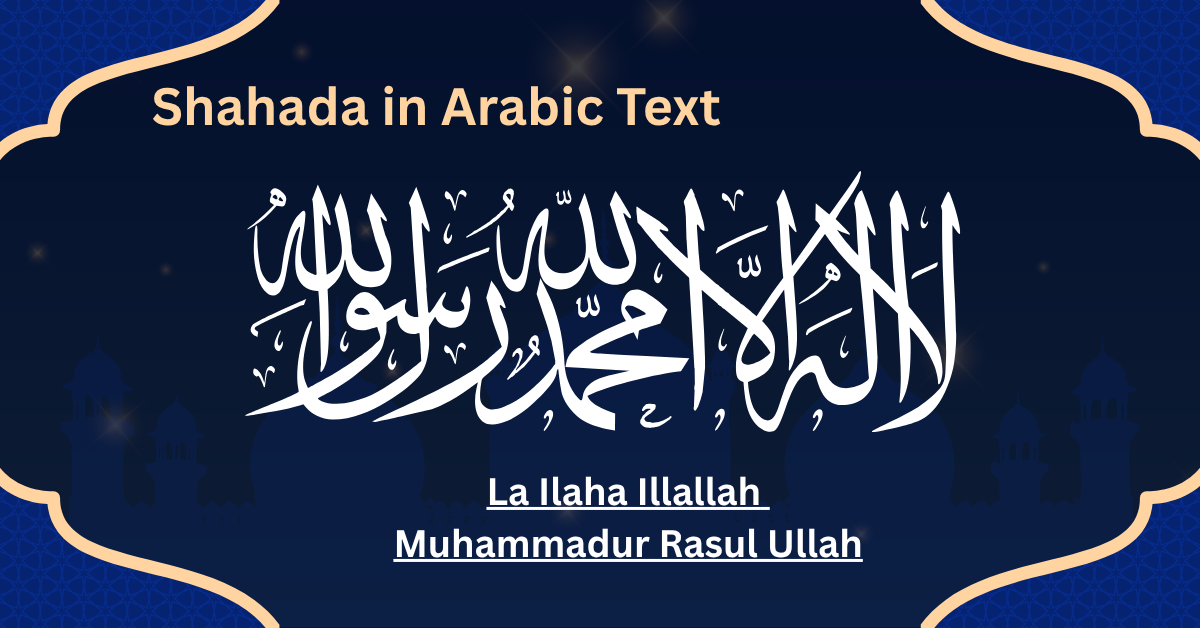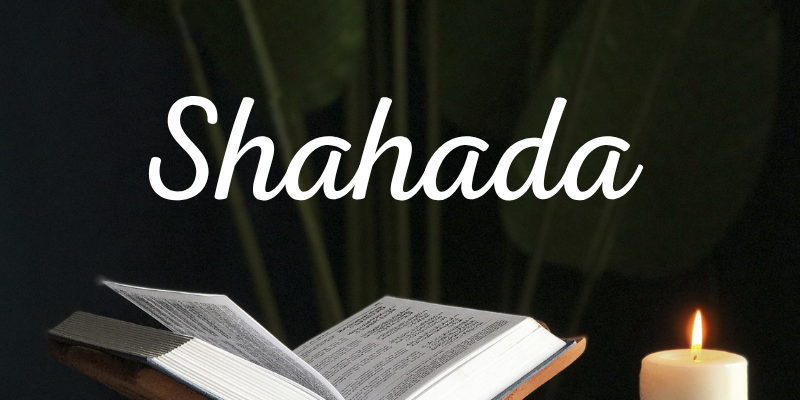
Shahada
The Shahada is a cornerstone of the Islamic faith. It’s a declaration that holds profound significance for Muslims worldwide.
This simple yet powerful statement is the first of the Five Pillars of Islam. It’s a testament to the oneness of God and the prophethood of Muhammad.
But what does it mean to recite the Shahada? And how does it shape the lives of those who declare it?
In this article, we delve into the meaning and importance of the Shahada. We explore its recitation, its role in daily life, and its influence on Muslim identity.
Whether you’re a student of religious studies, a new convert to Islam, or simply curious about Islamic practices, this comprehensive guide will provide valuable insights.
Join us as we journey through the profound depths of the Shahada, a declaration that resonates in the hearts of over a billion Muslims worldwide.
Understanding Shahada: The Cornerstone of Islamic Faith
The Shahada holds a place of unparalleled prominence in Islam, regarded as the fundamental testimony of faith. This declaration asserts two central beliefs: the oneness of God, referred to as Tawheed, and the recognition of Muhammad as His messenger. At its core, the Shahada is more than just a statement; it is a profound commitment to the principles and lifestyle exemplified by the Islamic faith. Understanding the depth and significance of the Shahada requires exploring its phrasing, the context in which it is recited, and the impact it has on a Muslim’s life. The Shahada acts as a bridge, connecting individuals to the broader Muslim community and affirming shared beliefs and values. It serves as both a personal affirmation and a communal bond, uniting Muslims worldwide in a common expression of monotheism. The widespread recitationof the Shahada permeates daily rituals and momentous life events, marking it as a cornerstone of Islamic practice.
What is Shahada?
The Shahada is a succinct proclamation of faith, pivotal in Islam. It succinctly declares: “There is no god but Allah, and Muhammad is His messenger.” This phrase forms the core of Islamic doctrine and is required for conversion to Islam. Reciting the Shahada with sincerity signifies embracing the Islamic faith and its tenets. This declaration reflects the essence of Islam’s monotheistic beliefs, emphasizing that Allah is the sole deity. Furthermore, acknowledging Muhammad as Allah’s messenger connects Muslims to the continuity of divine revelation delivered through the Prophet. Embracing the Shahada entails a lifelong commitment to follow Islamic teachings and emulate the Prophet’s practices.

The Components of Shahada
The Shahada is composed of two key components, each carrying significant theological weight. First, it affirms the singularity of God with the words “La ilaha illallah” — “There is no deity but Allah.” This acknowledges the unique and unparalleled divinity of Allah, asserting monotheism as a core belief. The second component, “Muhammadur rasulullah,” translates to “Muhammad is the messenger of Allah.” This second part reinforces the recognition of Muhammad’s role as the final prophet in Islam, conveying God’s message to humanity. Together, these components encapsulate the essence of the Islamic faith, providing a basis for all further beliefs and practices in Islam.
The Importance of Shahada in Islam
The Shahada holds immense importance in Islam as it is considered the foundational statement of faith. It is the gateway to all other religious duties and acts as a declaration that a person fully identifies as a Muslim. Reciting the Shahada is required to convert to Islam, marking a formal acceptance of Islamic beliefs and principles. It serves as a constant reminder for Muslims to lead lives aligned with Islamic values, fostering personal and spiritual growth. The Shahada’s significance extends beyond individual faith, uniting Muslims across cultures and nations in their shared belief and devotion.
Shahada as the First Pillar
In Islam, the Shahada is the first of the Five Pillars, highlighting its foundational role. The Five Pillars are the framework of a Muslim’s life, and the Shahada is the entry point into this structured practice. By reciting the Shahada, Muslims affirm their faith and commitment to live by the other pillars: prayer, almsgiving, fasting, and pilgrimage. As the first pillar, the Shahada is not only the starting point of a Muslim’s religious journey but also the continual affirmation of their devotion. It underpins all religious obligations, ensuring that a Muslim’s actions are rooted in sincere belief.
Spiritual Significance for Muslims
For Muslims, the Shahada is deeply spiritual, offering both comfort and guidance. It is more than a verbal assertion; it is a reflection of faith that permeates daily life. Reciting the Shahada instills a sense of peace, reminding Muslims of their connection to Allah and grounding them during life’s challenges. The declaration reinforces the concept of Tawheed, the oneness of God, fostering a holistic understanding of life’s purpose. Spiritually, it is a source of strength, empowering Muslims to adhere to ethical principles and to cultivate inner serenity. By regularly reflecting on the Shahada, Muslims reinforce their commitment to an authentic and meaningful relationship with Allah.
Shahada Recitation
The act of reciting the Shahada holds a profound significance and impact on a Muslim’s spiritual life. Recitation is not merely about uttering words; it involves a deep internal realization of faith. The Shahada is most impactful when it is recited with full awareness and sincerity of heart. For individuals embracing Islam, the Shahada represents the pivotal moment of entering the Muslim community, confirming belief in Allah and Muhammad as His messenger. Regular recitation during daily prayers serves as a reaffirmation of faith and offers spiritual nourishment. Muslims often recite the Shahada in private meditation or reflection, which deepens their connection to Allah and their identity as Muslims. Beyond prayer, the Shahada is articulated during religious ceremonies and significant life events, such as birth and at moments of death, symbolizing both beginnings and endings within the Islamic faith. This recitation is more than ritual; it is the heart’s devotion spoken out loud, linking the worshipper directly to the divine. Emphasizing the pivotal role it plays, the Shahada is foundational both at the individual and communal level, reinforcing a shared commitment among Muslims worldwide.
How to Properly Recite Shahada
To recite the Shahada effectively, it is vital to ensure precise pronunciation and sincere intention. The Shahada in Arabic is “Ashhadu an la ilaha illallah, wa ashhadu anna Muhammadur rasulullah.” It’s essential to pronounce each word clearly to convey its meanings accurately. Muslims often learn the Shahada from an early age, ensuring familiarity with its linguistic nuances. For converts, guidance from knowledgeable Muslims or Islamic scholars is crucial to mastering the correct articulation. A critical aspect of recitation is the niyyah, or intention. The individual must recite with an open heart, genuinely accepting the truth of the declaration. This intention transforms the recitation from mere words into a profound personal and spiritual commitment. Furthermore, the Shahada can be recited audibly or silently, yet the importance of contemplation remains constant. This thoughtful approach ensures that each utterance nurtures the soul and strengthens the bond with Allah.
Common Errors in Recitation
Reciting the Shahada requires meticulous attention to articulation, as even minor errors can alter its meaning. One common mistake is incorrect pronunciation of certain Arabic letters, which can change the word’s significance. For example, the Arabic letters ‘ha’ and ‘kha’ must be clearly distinguished. Mispronouncing the Prophet’s name, Muhammad, often occurs among non-native speakers, which can undermine the declaration’s completeness. Additionally, hasty recitation without full comprehension often leads to stumbling over the words, disrupting the spiritual flow. This highlights the necessity for understanding each component of the Shahada, ensuring an authentic connection to its message. Another common error is reciting without genuine intention or not reflecting on its profound significance. This can render the recitation hollow, missing the essential spiritual engagement. Therefore, it’s important for individuals reciting the Shahada to seek correct guidance and training, allowing for meaningful and accurate affirmation of their faith. Awareness of these potential pitfalls helps maintain the purity and power of this key Islamic declaration.
Shahada in Arabic
The Shahada in Arabic is not only a declaration of faith but also a testament to the linguistic beauty of the language. Arabic plays a critical role in Islam, being the original language of the Quran and essential in Islamic worship. The Arabic script of the Shahada is both succinct and full of spiritual depth. Its words are memorized by millions, echoing with uniformity across diverse cultures and regions. Despite language barriers, the Arabic text of the Shahada bonds Muslims globally, reinforcing a shared faith through linguistic unity. Embodied in its script is the essence of Tawheed, the oneness of God, which is central to Islamic creed. For many, learning to recite the Shahada in Arabic is a stepping stone to further linguistic and theological exploration, providing deeper insight into Islamic teachings. Reciting it in its original form fosters a direct link to the time of Prophet Muhammad, maintaining historical and spiritual continuity.
The Arabic Text
The Arabic text of the Shahada is concise yet powerful: “أشهد أن لا إله إلا الله وأشهد أن محمدًا رسول الله”. This translates to “I bear witness that there is no deity but God, and I bear witness that Muhammad is the messenger of God.” Each word in this text carries profound theological meaning. The phrase starts with “Ashhadu,” meaning “I bear witness,” emphasizing personal testimony and conviction. “An la ilaha illallah,” declares the absolute monotheism at the heart of Islam, rejecting any form of polytheism. The second part, “wa ashhadu anna Muhammadur rasulullah,” acknowledges Muhammad’s role as the final messenger, confirming the continuance and culmination of the prophetic tradition. Mastery of this text in Arabic allows believers to connect with Islam’s rich history, as well as its present-day global community. Understanding the meaning deeply enhances spiritual devotion and the Shahada’s purpose in daily life.
Calligraphic Representations
The Shahada’s calligraphic representations are artistic expressions found in Islamic culture, combining spiritual significance with visual beauty. Islamic calligraphy transforms the Shahada into a work of art, adorning mosques, manuscripts, and everyday items. These representations serve both decorative and educational purposes, reminding Muslims of their faith wherever they may be. The script can vary from simple designs to intricate patterns, reflecting the artist’s style and cultural influences. Calligraphy of the Shahada may be seen on walls of mosques, emphasizing the sacredness of the space. At times, the Shahada calligraphy is used in textiles, adornments, or even flags, ensuring the presence of faith in multiple aspects of daily life. These artistic forms invite reflection on the divine message, encouraging meditation and understanding. Through such visual expressions, the Shahada transcends verbal recitation, offering a contemplative experience that nourishes the observer’s faith. The perpetuation of this art form preserves and honors Islamic heritage, blending tradition with personal inspiration.
Shahada in Daily Life
The Shahada is not merely an abstract theological concept; it permeates the daily lives of Muslims worldwide. It serves as a constant reminder of faith and purpose. By embodying its principles, Muslims align their daily actions with their spiritual beliefs. It is not just spoken but lived, reflecting a commitment to live a life of integrity and devotion. From the beginning to the end of a day, the Shahada influences thoughts, choices, and interactions. Its recitation provides peace and strength, particularly during moments of trial and hardship. In every prayer, the Shahada is echoed, reinforcing the believer’s connection to God. It’s an anchor that guides moral and ethical decisions, reminding Muslims of their allegiance to God’s commandments. Beyond prayer, it affects interactions with others, promoting kindness, honesty, and respect. Thus, the Shahada’s significance extends beyond worship, shaping the core of a Muslim’s conduct and outlook on life.
Daily Prayers and Shahada
In Islam, daily prayers, known as Salah, are incomplete without the Shahada. This testimony of faith is intrinsic to the Islamic prayer ritual. Throughout the five daily prayers, Muslims reaffirm the oneness of God and the prophethood of Muhammad by reciting the Shahada. It is woven into the fabric of prayer, marking both beginnings and conclusions. The act of verbalizing this declaration reinforces a spiritual commitment, while enabling meditation on its profound meaning. Each repetition of the Shahada during prayers invites reflection on its implications, prompting a continuous spiritual awakening. This regular recitation integrates the believer’s life with Islamic principles, ensuring faith remains at the heart of everyday activities. For many, the rhythm of prayer and the utterance of the Shahada offer solace and focus amidst life’s distractions. It strengthens resolve, nourishing a consistent consciousness of divine presence and guidance in all endeavors.
Influence on Muslim Identity
The Shahada is pivotal in shaping the identity of Muslims across the globe. As the cornerstone of Islamic belief, it is more than just words; it embodies a profound personal declaration of faith. The act of declaring the Shahada signifies both personal conviction and a shared identity within the global Muslim community. It unites a diverse population under a singular ideological canopy, transcending geographical, cultural, and linguistic boundaries. The Shahada is often the first element of Islam taught to children, embedding it in the foundation of their spiritual and ethical upbringing. It influences personal identity by instilling principles of monotheism, commitment to truth, and perseverance in faith. Additionally, it asserts a cultural identity marked by a connection to the broader Islamic ummah. Whether displayed in calligraphy at home or pondered in personal reflection, the Shahada shapes and reinforces what it means to be a Muslim. It is a symbol of continuity and unity, cherished individually and collectively.

